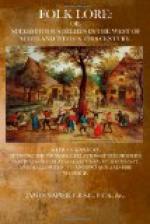To meet a sow the first thing in the morning boded bad luck for the day.
If a male cat came into the house and shewed itself friendly to any one, it was a lucky omen for that person.
To meet a piebald horse was lucky. If two such horses were met apart, the one after the other, and if then the person who met them were to spit three times, and express any reasonable wish, it would be granted within three days.
If a stray dog followed any person on the street, without having been enticed, it was lucky, and success was certain to attend the errand on which the person was engaged.
CHAPTER IX.
SUPERSTITIONS CONCERNING PLANTS.
Superstitions connected with plants were more numerous than those connected with animals. We have already noticed widespread prevalence of tree worship in early times. The Bible is full of evidence bearing upon this point, from the earliest period of Jewish history until the time of the captivity. Even concerning those Kings of Judah and Israel who are recorded to have walked in the ways of their father David, it is frequently remarked of them that they did not remove or hew down the groves, but permitted them to remain a snare to the people. In several instances the word translated grove cannot properly be applicable to a grove of trees, but must signify something much smaller, for it is in these instances described as being located in the temple. It can therefore refer only to a tree or stump of a tree, or it may be only the symbol of a tree. The story of the tree of good and evil, and the tree of life, has been the origin of many superstitious notions regarding trees. The notion that the tree of the knowledge of good and evil was an apple tree, caused the apple to have a great many mystic meanings, and gave it a prominent place in many legends, and also brought it into prominence as a divining medium. In many parts of Scotland the apple was believed to have great influence in love affairs. If an apple seed were shot between the fingers it was understood that it would, by the direction of its flight, indicate the direction from which that person’s future partner in life would come. If a couple took an apple




